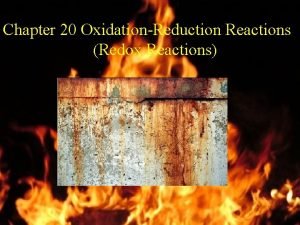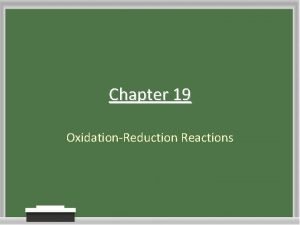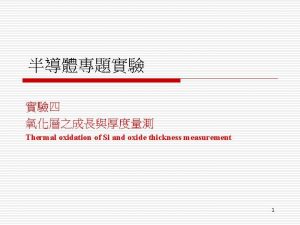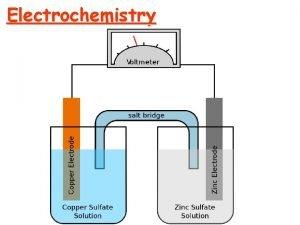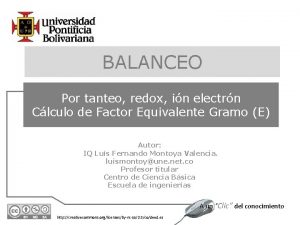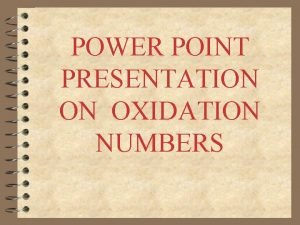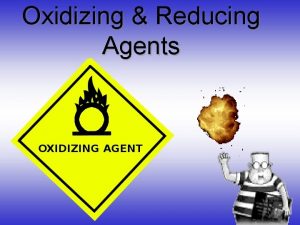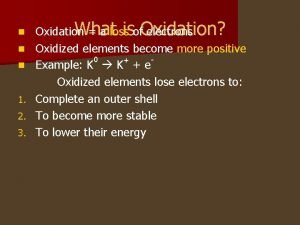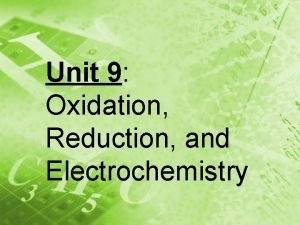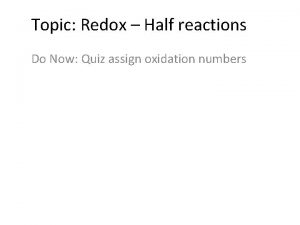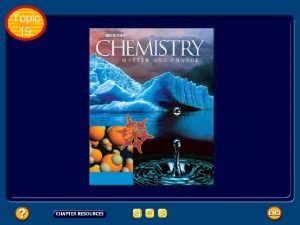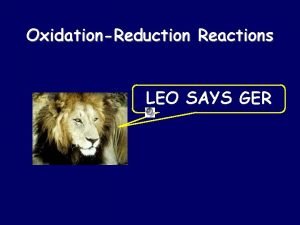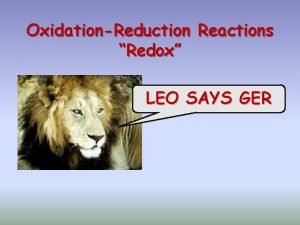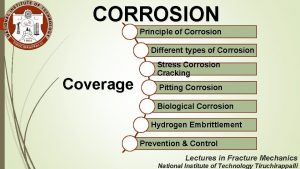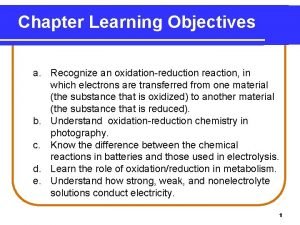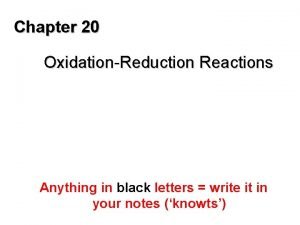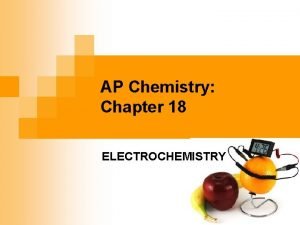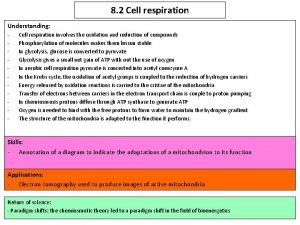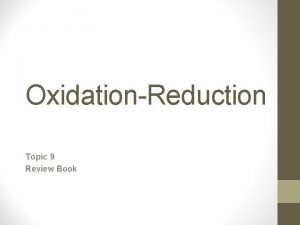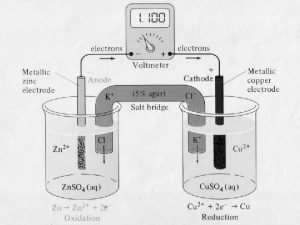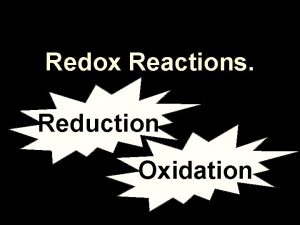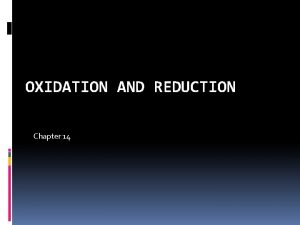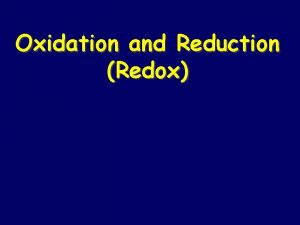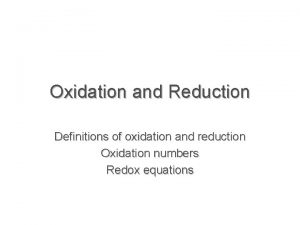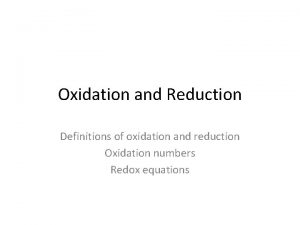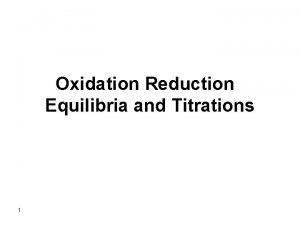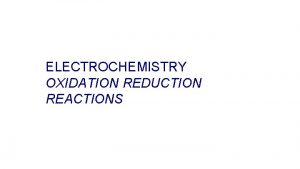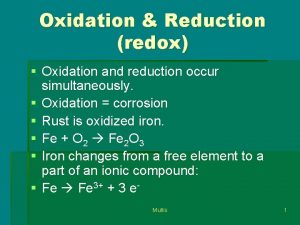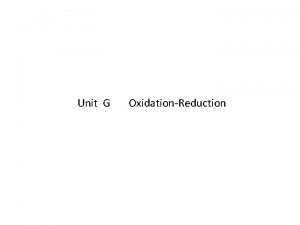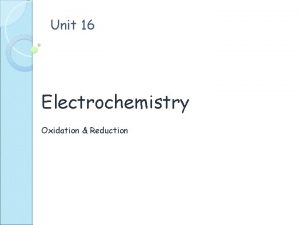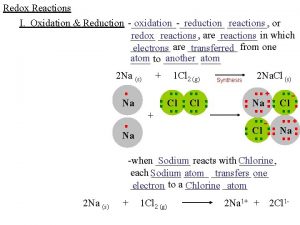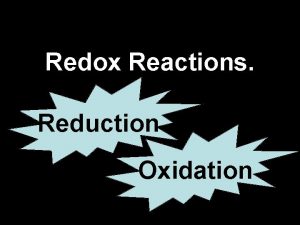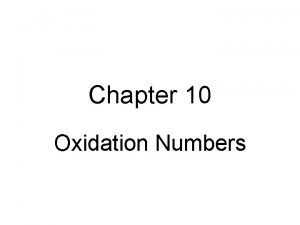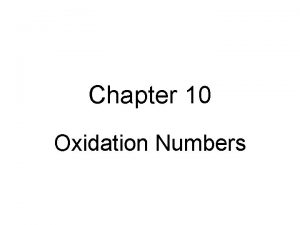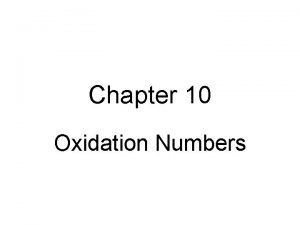Chapter 20 OXIDATION AND REDUCTION PHOTOSYNTHESIS reduction of



























- Slides: 27

Chapter 20 OXIDATION AND REDUCTION PHOTOSYNTHESIS: reduction of CO 2 CELLULAR RESPIRATION: oxidation of glucose

Oxidation-Reduction: Basic Concepts Electron Transfer and Redox Reactions • One of the defining characteristics of singlereplacement and combustion reactions is that they always involve the transfer of electrons from one atom to another.

Electron Transfer and Redox Reactions • Often synthesis and decomposition reactions also involve the transfer of electrons.

Electron Transfer and Redox Reactions • In this reaction, an electron from each of two magnesium atoms is transferred to the O 2 molecule to form two O– ions. • An example of a combustion reaction is the burning of magnesium in air.

Electron Transfer and Redox Reactions • When magnesium reacts with oxygen, each magnesium atom transfers two electrons to each oxygen atom.

Electron Transfer and Redox Reactions 2+ • The two magnesium atoms become Mg ions and the two oxygen atoms become O 2–ions (oxide ions). • If you compare this reaction with the reaction of sodium and chlorine, you will see that they are alike in that both involve the transfer of electrons between atoms.

Electron Transfer and Redox Reactions • A reaction in which electrons are transferred from one atom to another is called an oxidation–reduction reaction. • For simplicity, chemists often refer to oxidation– reduction reactions as redox reactions.

Electron Transfer and Redox Reactions • Now consider the single-replacement reaction in which chlorine in an aqueous solution replaces bromine from an aqueous solution of potassium bromide.

Electron Transfer and Redox Reactions • Note that chlorine “steals” electrons from bromide ions to become chloride ions. • When the bromide ions lose their extra electrons, the two bromine atoms form a covalent bond with each other to produce Br 2 molecules.

Electron Transfer and Redox Reactions • The result of this reaction, the characteristic color of elemental bromine in solution. • The formation of the covalent bond by sharing of electrons also is an oxidation– reduction reaction.

How do oxidation and reduction differ? • oxidation is defined as the loss of electrons from atoms of a substance • To state this reaction more clearly, • For oxidation to take place, the electrons lost by the substance that is oxidized must be accepted by atoms or ions of another substance.

How do oxidation and reduction differ? • In other words, there must be an accompanying process that involves the gain of electrons. • Reduction is defined as the gain of electrons by atoms of a substance.

How do oxidation and reduction differ? • It is important to recognize and distinguish between oxidation and reduction. • The following memory aid may help. • LEO the lion says GER or, for short, LEO GER • This phrase will help you remember that Loss of Electrons is Oxidation, and Gain of Electrons is Reduction.

Changes in oxidation number • The oxidation number of an atom in an ionic compound is the number of electrons lost or gained by the atom when it forms ions. • Like some of the other tools you have learned about in chemistry, oxidation numbers have a specific notation. • Oxidation numbers are written with the positive or negative sign before the number (+3, +2), whereas ionic charge is written with the sign after the number (3+, 2+). • Oxidation number: +3 • Ionic charge: 3+

Oxidizing and Reducing Agents • The substance that oxidizes another substance by accepting its electrons is called an oxidizing agent. • This term is another way of saying “the substance that is reduced. ”

Oxidizing and Reducing Agents • The substance that reduces another substance by losing electrons is called a reducing agent. • A reducing agent supplies electrons to the substance getting reduced (gaining electrons), and is itself oxidized because it loses electrons.

Oxidizing and Reducing Agents • By this definition, the reducing agent in the potassium–bromine reaction is potassium, the substance that is oxidized.

Oxidizing and Reducing Agents • A common application of redox chemistry is to remove tarnish from metal objects, such as a silver cup.

Oxidizing and Reducing Agents • Hydrogen peroxide (H 2 O 2) can be used as an antiseptic because it oxidizes some of the vital biomolecules of germs, or as an agent to lighten hair because it oxidizes the dark pigment of the hair.

Redox and Electronegativity • The chemistry of oxidation–reduction reactions is not limited to atoms of an element changing to ions or the reverse.

Redox and Electronegativity • Some redox reactions involve changes in molecular substances or polyatomic ions in which atoms are covalently bonded to other atoms. • For example, the following equation represents the redox reaction used to manufacture ammonia.

Redox and Electronegativity • For the purpose of studying oxidation– reduction reactions, the more electronegative atom (nitrogen) is treated as if it had been reduced by gaining electrons from the other atom.

Redox and Electronegativity • The less electronegative atom (hydrogen) is treated as if it had been oxidized by losing electrons.

Identifying Oxidation– Reduction Reactions • The following equation represents the redox reaction of aluminum and iron. • Identify what is oxidized and what is reduced in this reaction.

Question 1 For each of the following reactions, identify what is oxidized and what is reduced. Also identify the oxidizing agent and the reducing agent.

Question 1 a Answer 1 a Zn; Ni 2+; Zn

Question 1 b Answer 1 b I–; Br 2; I–
 Oxidation reduction reactions chapter 19 review
Oxidation reduction reactions chapter 19 review Chapter 20 oxidation-reduction reactions answer key
Chapter 20 oxidation-reduction reactions answer key How to write reduction half reactions
How to write reduction half reactions Locos bird's beak
Locos bird's beak Cathode and anode half reactions
Cathode and anode half reactions Concentration cell
Concentration cell Half reduction reaction
Half reduction reaction Balanceo por redox
Balanceo por redox What is oxidation
What is oxidation Oxidizing agent examples
Oxidizing agent examples What isof
What isof Which equation represents an oxidation-reduction reaction
Which equation represents an oxidation-reduction reaction Oxidation reduction quiz
Oxidation reduction quiz Which equation represents an oxidation-reduction reaction
Which equation represents an oxidation-reduction reaction Leo says ger
Leo says ger Basic redox reactions
Basic redox reactions Underprocessed hair is usually:
Underprocessed hair is usually: Leo goes ger chemistry
Leo goes ger chemistry Oxidative corrosion
Oxidative corrosion Oxidation–reduction reactions
Oxidation–reduction reactions Leo ger oxidation reduction
Leo ger oxidation reduction Leo the lion says ger
Leo the lion says ger Reactions19
Reactions19 Ap chemistry electrochemistry
Ap chemistry electrochemistry Respirometer
Respirometer An ox red cat
An ox red cat Topic 9 oxidation-reduction
Topic 9 oxidation-reduction Galvanic cell cathode
Galvanic cell cathode

